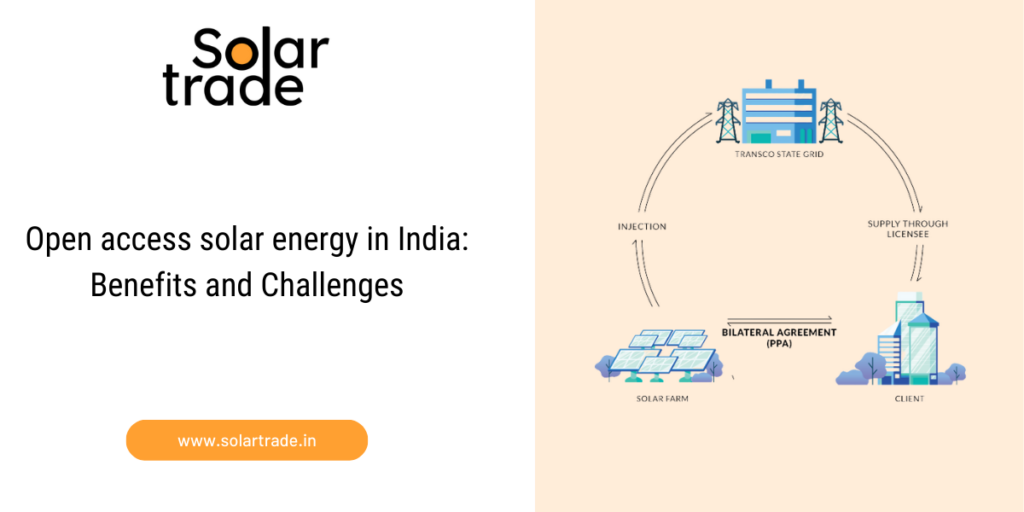
Open access solar energy refers to the provision of solar power to consumers, such as commercial and industrial entities, through third-party solar developers or Independent Power Producers (IPPs). It allows consumers to procure solar power directly from a solar project located remotely, bypassing the need for setting up individual rooftop solar installations.
The open access model operates on the principle of a power purchase agreement (PPA) between the consumer and the solar developer. The consumer agrees to purchase a predetermined quantity of solar power at an agreed-upon tariff for a specific duration. This arrangement enables businesses to leverage solar energy without incurring high capital costs or investing in system maintenance. In this article, we will try to understand the open access solar energy in India with its benefits and chakllenges.
Open-access solar energy offers several benefits for consumers, developers, investors, and the environment, such as:
Lower electricity costs: Open access solar tariffs are usually lower than the grid tariffs charged by discoms, especially for commercial and industrial (C&I) consumers who pay high cross-subsidy charges. For example, in Karnataka, the average open-access solar tariff was INR 3.5 per kWh in 2020, while the average C&I tariff was INR 7.5 per kWh.
Higher renewable energy consumption: Open access solar enables consumers to meet their renewable purchase obligations (RPOs) and voluntary commitments to green energy. Many Indian corporates have pledged to consume 100% renewable energy, such as Tata Motors, Infosys and Mahindra and Mahindra.
Increased renewable energy generation: Open-access solar provides an alternative market for renewable energy developers and investors, who can sell power to large consumers at competitive prices and with long-term contracts. This can help India achieve its ambitious target of 175 GW of renewable energy capacity by 2022, of which 100 GW is expected to come from solar energy.
Reduced greenhouse gas emissions: Open-access solar reduces the dependence on fossil fuel-based power generation and contributes to India’s climate change mitigation efforts. According to a report by Mercom India, open-access solar projects avoided about 4.6 million tonnes of carbon dioxide emissions in 2020.

However, open-access solar also faces several challenges and barriers in India, such as:
Uncertain and high open access charges: Open access consumers have to pay various charges to use the transmission and distribution network, such as cross-subsidy surcharge (CSS), additional surcharge (AS), wheeling charges, transmission charges, standby charges, etc. These charges vary across states and are often revised frequently and unpredictably by regulators and discoms. This increases the uncertainty and cost of open-access solar projects and discourages consumers from opting for them.
Regulatory hurdles and delays: Open access consumers have to obtain approvals from multiple authorities, such as state load dispatch centers (SLDCs), regional load dispatch centers (RLDCs), discoms, etc. The approval process is often lengthy, cumbersome, and non-transparent, involving multiple documents and fees. Moreover, some states impose restrictions on open access transactions, such as imposing banking and scheduling charges, limiting the contract duration, imposing minimum consumption limits, etc.
Discom opposition and curtailment: Discoms are often opposed to open-access solar projects as they lose their high-paying C&I consumers and revenue. Discoms may resort to curtailment of open access power supply, citing grid stability or technical issues. Curtailment reduces the generation and revenue of open-access solar projects and affects their viability.
Be the part of Solartrade Community: Learn about solar, Use the Solartrade Tech Solutions and Grow your Solar Business.
Recent Developments in open access solar energy in India
To address some of these challenges and promote open access solar in India, the Ministry of Power recently released the ‘Green Open Access Rules, 2022’ which aim to provide a simplified, uniform, and streamlined procedure for granting open access to green energy. Some of the key features of these rules are:
1) Reduction in the limit of open access transactions from 1 MW to 100 kW for green energy
2) Removal of additional surcharge on open-access consumers
3) Capping of cross-subsidy surcharge at 20% of the average cost of supply
4) Creation of a national portal for online application and approval of open access
5) Deemed approval if no response is received within 15 days
6) Issuance of green certificates to consumers who opt for green power
7) Uniform renewable purchase obligation for all entities in the area of a discom
8) Separate tariff determination for green energy by appropriate commissions
These rules are expected to incentivize consumers to go green and improve the predictability of cash flows for renewable power producers. However, their implementation and enforcement will depend on the cooperation and coordination of various stakeholders, such as state governments, regulators, discoms, SLDCs, RLDCs, etc.
Open Access Solar energy in India: Conclusion
Open-access solar energy is a promising avenue for scaling up renewable energy in India and achieving its climate and energy goals. However, it also faces several challenges and barriers that need to be overcome through policy reforms, regulatory interventions, and stakeholder engagement. The recent Green Open Access Rules, of 2022 are a welcome step in this direction, but they need to be followed by effective implementation and enforcement. Moreover, there is a need to create awareness and capacity among consumers, developers, investors, and discoms about the benefits and opportunities of open-access solar energy in India.